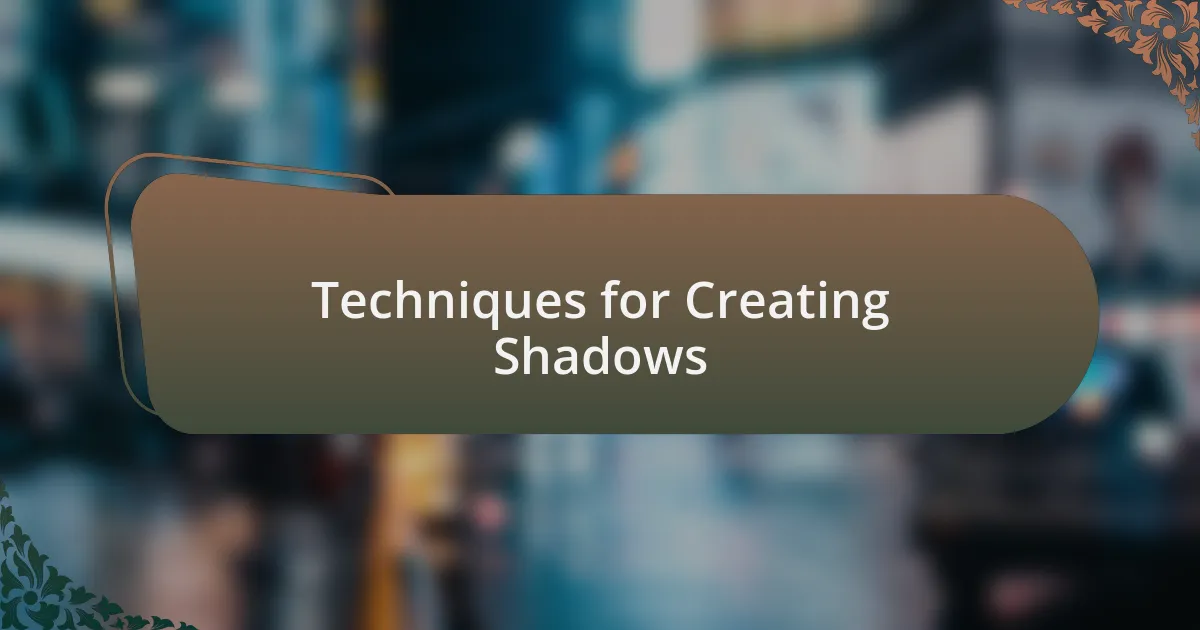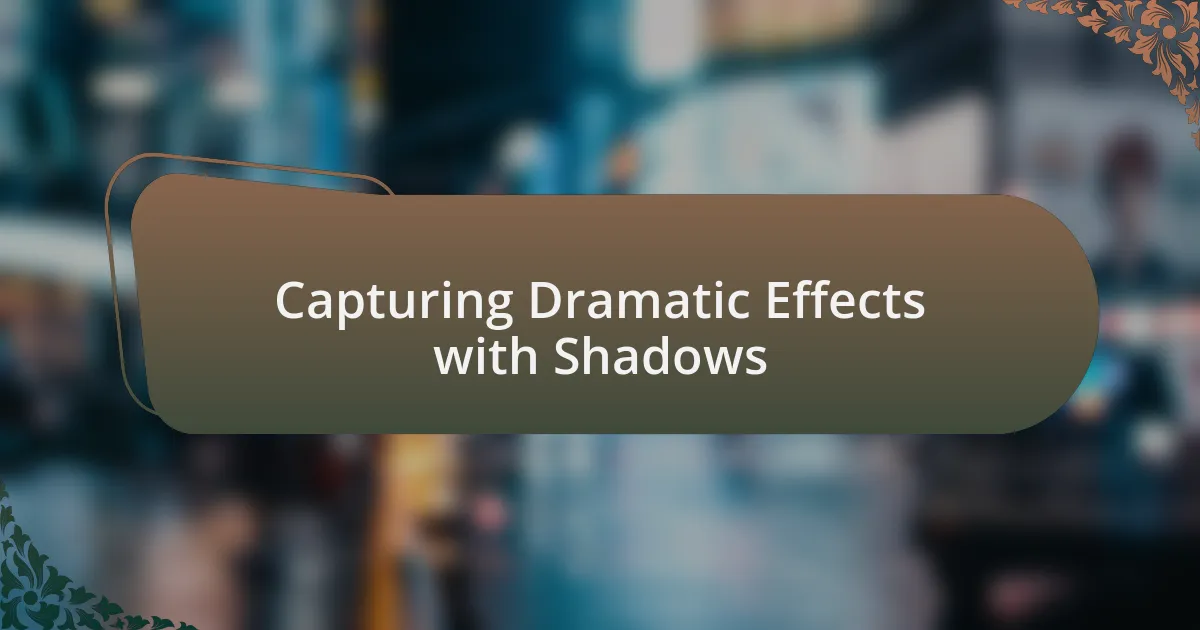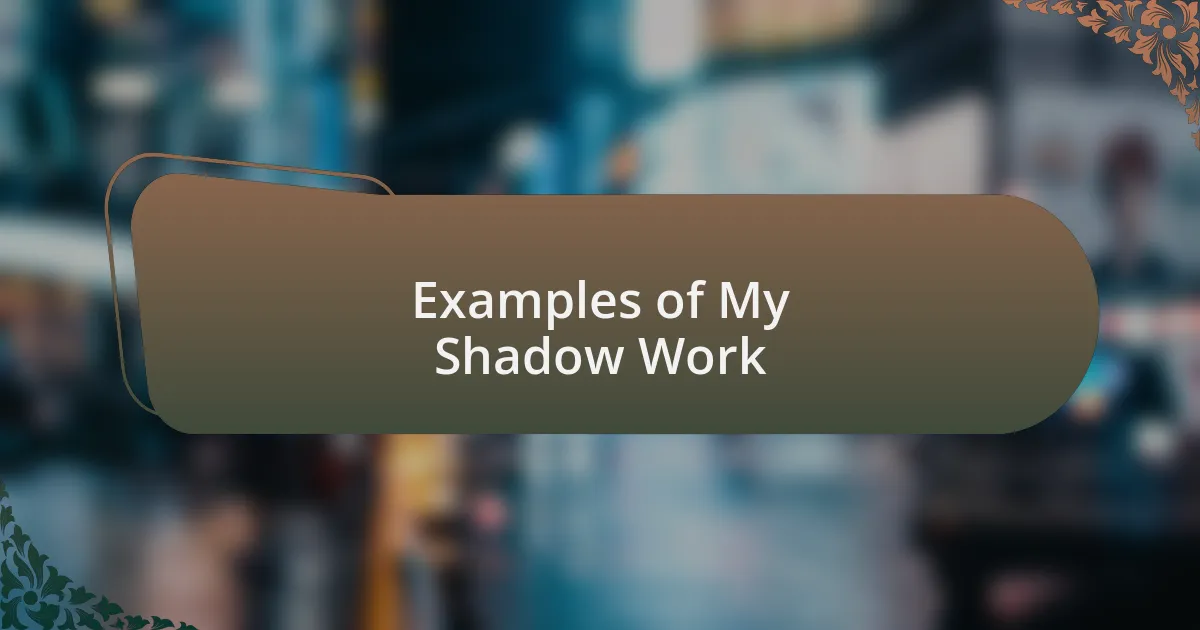Key takeaways:
- Shadows create depth and emotion in photography, guiding the viewer’s eye and enhancing composition.
- Techniques such as experimenting with light sources, camera angles, and shooting during the golden hour can yield compelling shadow effects.
- Shadows can evoke different moods and narratives, transforming ordinary scenes into powerful storytelling elements.
- Utilizing shadows as leading lines and contrasts enhances the viewer’s engagement and emotional connection to the image.

Importance of Shadows in Photography
Shadows in photography are often underestimated, yet they play a crucial role in creating depth and dimension. I remember one particular evening when the sun cast long shadows across an empty street, transforming a mundane scene into something almost hauntingly beautiful. This experience taught me that shadows can evoke emotions, adding layers of meaning that might not exist without them.
Consider how shadows can guide the viewer’s eye through an image. I often find myself using shadows to lead the gaze toward the main subject, ensuring that the photograph has a clear focal point. Isn’t it fascinating how a simple shadow can enhance the composition and draw attention where I want it?
Moreover, shadows can set the mood of a photograph. I once captured a portrait where the play of light and dark created a sense of mystery surrounding my subject. This interplay can change how a viewer feels about the image; it can evoke a sense of drama or tranquility, depending on how I choose to capture it. Shadows are more than just the absence of light; they are a vital component of storytelling in photography.

Techniques for Creating Shadows
When I’m looking to create compelling shadows in my black and white photos, I often experiment with different light sources. For instance, during a recent shoot in an industrial setting, the harsh morning sun cast dramatic silhouettes of machinery, lending an edgy vibe to the frames. By positioning my subject at an angle to the light, I was able to capture bold, contrasting shadows that added texture and interest to the overall composition.
Another technique I embrace involves manipulating the angle of my camera. I recall a time when I crouched low, aiming upwards at a lone tree against the sky. This perspective not only highlighted the intricate patterns of the leaves but also accentuated the shadows stretching downwards, creating an immersive experience for viewers. Have you ever experimented with different angles? Small changes can produce strikingly different shadow effects that breathe life into your photos.
Lastly, I believe in the power of timing when it comes to shadows. Shooting during the golden hour can transform ordinary scenes into something magical. I once photographed a couple walking hand in hand as the sun began to set, casting elongated shadows that intertwined on the ground. This not only emphasized their connection but also added a romantic feel to the image. Have you noticed how the time of day can change the narrative of your photos? Shadows created in those fleeting moments tell a story all their own.

Capturing Dramatic Effects with Shadows
When I think about capturing dramatic effects with shadows, I often remember a moment from a street photography session. I was wandering through an old part of town just after a rain shower when the low sun created striking reflections and shadows that danced across the cobblestones. The city’s architecture seemed to come alive, and I found myself framing shots that emphasized these shadows, transforming mundane street scenes into narratives filled with tension and emotion.
In another instance, I had the opportunity to shoot a model in a vintage dress standing against a weathered brick wall during a late afternoon. As the sun dipped lower, the shadows elongated across her figure, creating a sense of depth and intrigue. I was amazed at how these shadows contributed to a palpable mood, evoking feelings of nostalgia and longing. Have you ever encountered such moments where shadows seemed to whisper stories? I believe that these elements can profoundly affect how the viewer connects with an image.
Creating contrast with shadows also plays a crucial role in my photography. I remember an experiment where I set up a still life scene featuring an old guitar and sheet music under a single source of light. The deep shadows enveloped parts of the guitar body, enhancing its curves and lending a dramatic flair to the composition. Isn’t it fascinating how shadows can bring out details that might otherwise go unnoticed? I strive to utilize this interplay to evoke an emotional response, drawing the viewer into a deeper engagement with the artwork.

My Personal Approach to Shadows
When it comes to my personal approach to shadows, I see them as a vital character in every frame. For instance, I recall a late-night shoot where I used only the soft glow of street lamps. The shadows from trees cast intricate patterns on the pavement, giving the scene an almost ethereal quality. This experience reaffirmed my belief that shadows are not merely negatives; they can transform an ordinary setting into a canvas for expression.
I often find myself playing with different angles to see how shadows shift and change, bringing a dynamic element to my work. One cloudy afternoon, I stood in a park watching a child chase after bubbles. I positioned myself to capture the fleeting light as it passed through the clouds, casting fleeting shadows that seemed to dance with joy. It struck me how such simple moments, highlighted by shadows, can evoke a deeper emotional resonance. Who knew that a child’s laughter intertwined with shadows could create such a profound sense of happiness?
Another technique I embrace involves using shadows to create leading lines that draw the viewer’s eye into the frame. I remember a summer day when I shot a series of photographs in a local market. I noticed that shadows from market stalls could guide the observer’s gaze towards the vibrant colors of the produce. By incorporating these shadows into my compositions, I not only achieved balance but also invited viewers to engage more deeply with the story behind each image. Isn’t it amazing how a seemingly simple element like a shadow can elevate storytelling in photography?

Examples of My Shadow Work
The use of shadows in my black and white photography often leads to intriguing contrasts that elevate the overall impact of the images. One memorable afternoon, I wandered through an old industrial area, and the sun was setting at just the right angle. I snapped a shot of a rusty metal wall where the shadow of a nearby crane melded with the textures, creating a storyline of decay and resilience. This moment captured the essence of the site and forced me to reflect: how can shadows narrate the layered history behind a space?
Another powerful example comes from a recent portrait session. As I positioned my subject against a large window, I noticed the shadow patterns formed by a nearby tree. The interplay of light and shadow not only added depth to the photograph but also highlighted the emotions on my subject’s face. It was breathtaking to witness how the shadows seemed to tell their own story, accentuating vulnerability and strength. Have you ever realized how a mere shadow can encapsulate an entire emotional arc?
In a completely different setting, I embraced shadows during a cityscape photo shoot at dusk. The silhouettes of skyscrapers against the twilight sky were mesmerizing. I remember focusing on the shadows they cast on the streets below, transforming a bustling scene into something almost dreamlike. This made me wonder—could these shadows symbolize the stories of the countless individuals navigating the city? By inviting the viewer to see beyond the surface, I believe these shadow-filled images spark curiosity and connection.